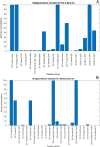Investigating the power of eyes open resting state EEG for assisting in dementia diagnosis
- PMID: 35932060
- PMCID: PMC9354304
- DOI: 10.1186/s13195-022-01046-z
Investigating the power of eyes open resting state EEG for assisting in dementia diagnosis
Abstract
Introduction: The differentiation of Lewy body dementia from other common dementia types clinically is difficult, with a considerable number of cases only being found post-mortem. Consequently, there is a clear need for inexpensive and accurate diagnostic approaches for clinical use. Electroencephalography (EEG) is one potential candidate due to its relatively low cost and non-invasive nature. Previous studies examining the use of EEG as a dementia diagnostic have focussed on the eyes closed (EC) resting state; however, eyes open (EO) EEG may also be a useful adjunct to quantitative analysis due to clinical availability.
Methods: We extracted spectral properties from EEG signals recorded under research study protocols (1024 Hz sampling rate, 10:5 EEG layout). The data stems from a total of 40 dementia patients with an average age of 74.42, 75.81 and 73.88 years for Alzheimer's disease (AD), dementia with Lewy bodies (DLB) and Parkinson's disease dementia (PDD), respectively, and 15 healthy controls (HC) with an average age of 76.93 years. We utilised k-nearest neighbour, support vector machine and logistic regression machine learning to differentiate between groups utilising spectral data from the delta, theta, high theta, alpha and beta EEG bands.
Results: We found that the combination of EC and EO resting state EEG data significantly increased inter-group classification accuracy compared to methods not using EO data. Secondly, we observed a distinct increase in the dominant frequency variance for HC between the EO and EC state, which was not observed within any dementia subgroup. For inter-group classification, we achieved a specificity of 0.87 and sensitivity of 0.92 for HC vs dementia classification and 0.75 specificity and 0.91 sensitivity for AD vs DLB classification, with a k-nearest neighbour machine learning model which outperformed other machine learning methods.
Conclusions: The findings of our study indicate that the combination of both EC and EO quantitative EEG features improves overall classification accuracy when classifying dementia types in older age adults. In addition, we demonstrate that healthy controls display a definite change in dominant frequency variance between the EC and EO state. In future, a validation cohort should be utilised to further solidify these findings.
Keywords: Alzheimer’s disease; Dominant frequency; Electrocenphalography; Eyes closed; Eyes open; Lewy body dementia; Machine learning; Parkinson’s disease; Quantitative.
© 2022. The Author(s).
Conflict of interest statement
The authors declare that they have no competing interests.
Figures


References
-
- Patterson C. The state of the art of dementia research: new frontiers. World Alzheimer Rep. 2018;2018:48.
-
- Toledo JB, Cairns NJ, Da X, Chen K, Carter D, Fleisher A, Householder E, Ayutyanont N, Roontiva A, Bauer RJ, Eisen P, Shaw LM, Davatzikos C, Weiner MW, Reiman EM, Morris JC, Trojanowski JQ. Clinical and multimodal biomarker correlates of ADNI neuropathological findings. Acta Neuropathol Commun. 2013;1:65. doi: 10.1186/2051-5960-1-65. - DOI - PMC - PubMed
-
- Prince M, Knapp M, Guerachet M, McCrone P, Prina M, Comas-Herra A, Wittenberg R, Adelaja B, Hu B, King D, Rehill A, Salimkumar D. Dementia UK: second edition - overview. 2014. p. 24.
Publication types
MeSH terms
Grants and funding
LinkOut - more resources
Full Text Sources
Medical

